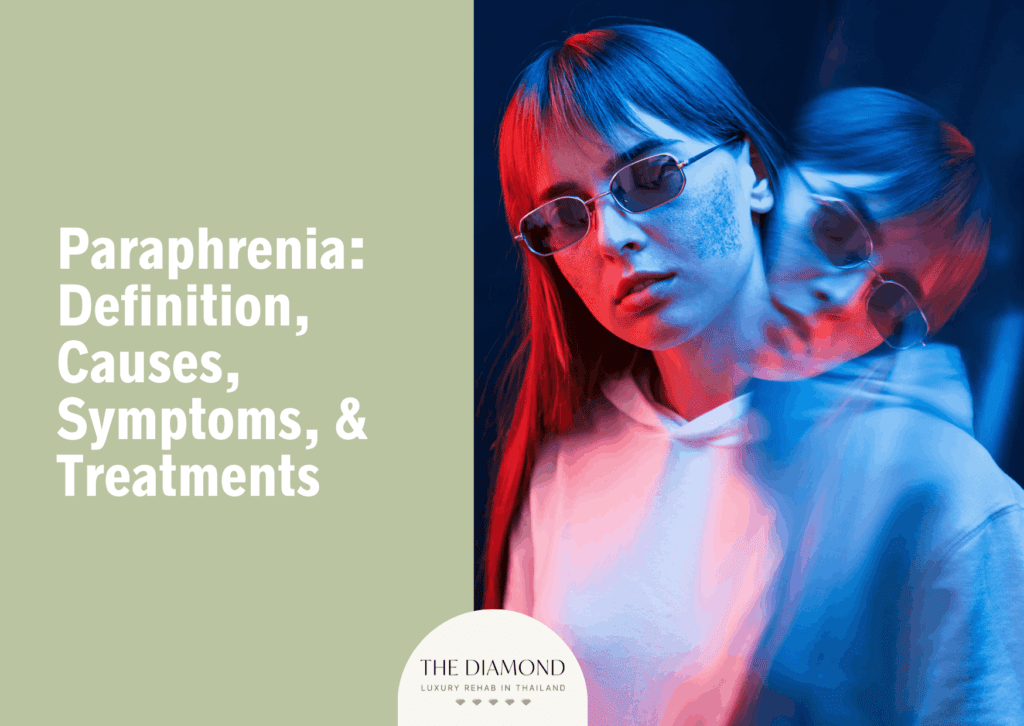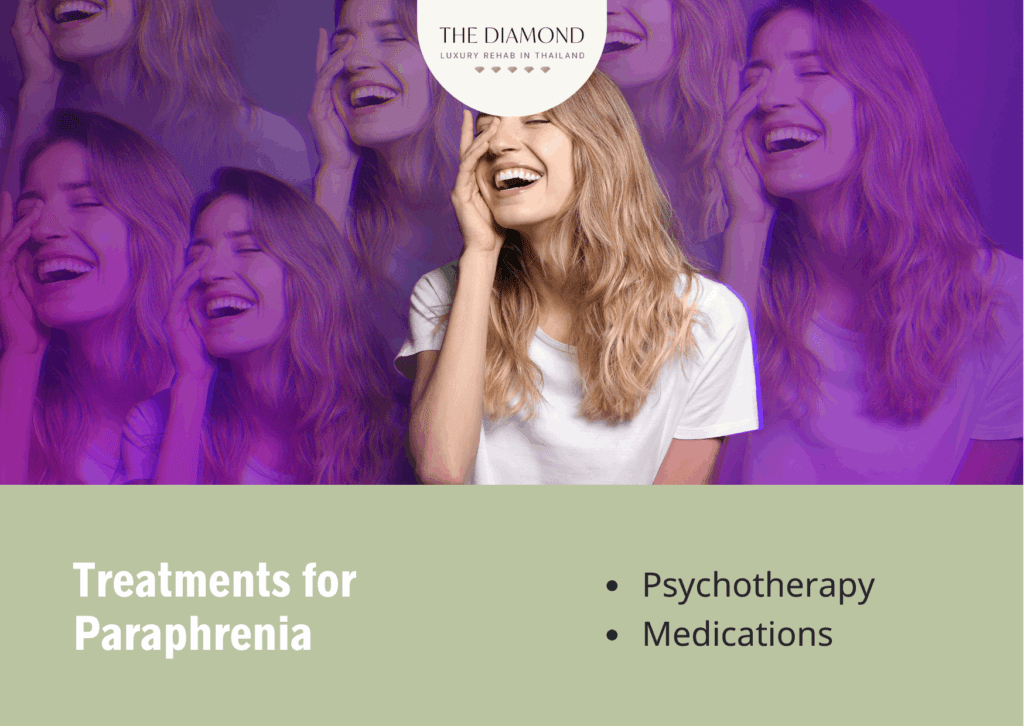Paraphrenia: definition, causes, symptoms, and treatments

Paraphrenia is a mental illness indicated by hallucinations and paranoid delusions, but without impairment in cognitive abilities and daily functioning. It’s one of the psychotic disorders, but at this point, paraphrenia isn’t included in DSM-5.
Causes of paraphrenia are neurological illnesses and stressful personal situations. That explains the late onset of this mental disorder, which usually affects elderly men and women.
The symptoms of paraphrenia are paranoid delusions, hallucinations, and hearing voices and noises that other people do not.
Treatment of paraphrenia includes therapy and medications such as antipsychotics. Since social isolation is a major problem and may contribute to paraphrenia, it’s essential to improve the social functioning of an individual. Socializing exhibits positive effects on the brain and improves the quality of life.
What is paraphrenia?

Paraphrenia is a type of psychotic disorder whose main features are paranoid delusions and hallucinations.
The condition usually affects men and women over the age of 40, especially elderly individuals with dementia or Parkinson’s disease. For that reason, it is often referred to as late-onset psychosis.
The reality is that paraphrenia isn’t included in DSM-5 (Diagnostic and Statistical Manual of Mental Disorders, Fifth Edition) by the American Psychiatric Association. However, healthcare professionals can still diagnose it as a separate condition. They do so to make a clear distinction between this and other psychotic disorders.
What makes paraphrenia different from other psychotic conditions is that it doesn’t affect someone’s personality and daily functioning. A person with paraphrenia doesn’t experience the impairment of intellectual abilities due to this condition.
Paraphrenia develops a lot later than other psychosis-related disorders.
Although poorly studied, paraphrenia was first described in 1913 by Emil Kraepelin, a German psychiatrist. He defined a group of psychotic patients who exhibited dementia symptoms with noticeable delusions but without disturbances of emotion and volition. Studies confirm this disorder is infrequently diagnosed.
What causes paraphrenia?
A combination of different causes leads to paraphrenia instead of one factor only. The causes of paraphrenia are listed below:
- Severe neurological illnesses
- Stressful personal situations
1. Severe Neurological Illnesses
Neurological illnesses are conditions that affect the brain and nerves throughout the human body and spinal cord. Common neurological illnesses include Alzheimer’s disease and other types of dementia, Parkinson’s disease, multiple sclerosis, brain tumors, infections, and other conditions.
The abovementioned conditions are associated with abnormalities in the brain’s structure and function. For that reason, they may also affect the way a person perceives reality. Someone with dementia is more likely to develop paraphrenia than a person who doesn’t have it. That happens because their health problem has impacted the brain in such a way it made it susceptible to hallucinations and delusions.
Medications such as dopaminomimetic therapy and anticholinergics, used in the treatment of some neurological illnesses, can also induce symptoms of psychosis, according to a paper from the Current Treatment Options in Neurology.
Psychosis in neurological illnesses isn’t uncommon. A study from the Journal of Managed Care & Specialty Pharmacy shows 20% to 70% of people with dementia will experience psychosis. A paper from the journal CNS Drugs suggested that around 90% of patients with dementia will develop some form of behavioral and psychological symptoms, including psychosis and aggression or agitation.
While further research on this subject is necessary, it’s useful to remember that neurological illnesses are progressive, and symptoms of psychosis may occur due to ongoing changes to the brain.
2. Stressful Personal Situations
Stressful personal situations are occurrences that cause a great deal of stress, frustration, and anxiety. These situations are particularly common among older adults. Elderly men and women tend to be socially isolated.
Due to social withdrawal, they can’t share their worries, stress, and other problems with family and friends. This makes it difficult for a person to process a stressful situation, which leads to emotional trauma to the brain.
A growing body of evidence confirms that psychosocial stress can induce symptoms of psychosis. A paper from the European Archives of Psychiatry and Clinical Neuroscience explains that chronic social isolation is strongly associated with psychotic symptoms.
Stressful situations and social isolation can contribute to the development of paraphrenia by inducing neurological and neurochemical deficits and behavioral problems.
What are the symptoms of paraphrenia?
Symptoms of paraphrenia are listed below:
- Paranoid delusions
- Hallucinations
- Hearing unreal sounds, noises, voices, and conversations
1. Paranoid delusions
Paranoid delusions, also known as delusions of persecution, are anxieties, fears, and false beliefs of being threatened by other individuals and external forces. This type of delusion revolves around victimization and unwarranted feelings.
In other words, a person feels other people or organizations (even government) are out to get them without evidence. They aren’t aware their thoughts are false but genuinely feel threatened, as if someone wants to harm them.
Physical effects of paranoid delusions include the consequences of too much stress, such as poor sleep, lack of personal hygiene, unhealthy diet, and weight gain. Due to unhealthy lifestyle choices, people who experience these symptoms are more susceptible to various health problems.
Behavioral effects include constantly questioning and confronting or accusing others, being defensive, argumentative behavior, hostility, and aggression. Relationship problems and family conflicts are also common.
2. Hallucinations
Hallucinations are false sensory experiences. To the affected person, they appear real but they’re not. Hallucinations can affect all senses, but most people experience auditory and visual types. Auditory hallucinations involve hearing sounds or voices that other people don’t. Visual hallucinations revolve around seeing things that other people do not.
Physical effects of hallucinations can include vision or hearing problems, headaches, lack of self-care, and problems associated with it.
The behavioral effects of hallucinations are frustration, depression, erratic behavior, and aggressiveness.
3. Hearing unreal sounds, noises, voices, and conversations
Hearing unreal sounds, noises, voices, and conversations is a temporary symptom that may cause significant discomfort to a person with psychosis. To people with paraphrenia, the sounds or voices and noises they hear are real. However, other people can’t hear them. The voices may come from a single source, such as TV, or multiple sources. Some people hear one voice, whereas others hear multiple voices.
The effects of this symptom are largely behavioral. Hearing sounds or voices that don’t exist is a major source of stress and frustration, which can lead to bizarre and angry behaviors as well as social isolation.
How is paraphrenia diagnosed?
Paraphrenia is diagnosed after a psychiatric evaluation and a physical exam. The latter is necessary to determine whether the source of psychosis is a physical problem such as dementia. For that purpose, blood tests, urine tests, and imaging tests such as MRI may be necessary.
At the same time, psychiatric evaluation helps doctors learn more about a patient’s symptoms, thoughts, behavioral patterns, and overall psychological health. A psychiatrist may also interview the patient’s family members.
A healthcare professional will diagnose paraphrenia when a patient experiences symptoms of psychosis but is still able to carry on with daily life and perform their chores normally. Patients with this disorder have a clear sense of space and time, and their paranoia and hallucinations are temporary.
How is paraphrenia prevented?
There is no specific way to prevent paraphrenia. Since the condition affects socially isolated elderly, it could be useful to be more social.
Reducing social isolation and increasing the level of community engagement can lower the risk or delay different forms of dementia and hence help with paraphrenia. Options are endless, including eldercare centers, befriending services, hobbies, classes and community work such as volunteering and participating in events organized by senior centers or community-oriented organizations.
People who have experienced stressful or traumatic events need help to cope with trauma in a healthy way. Helping them through therapy can improve their psychological well-being.
What are the possible treatments for paraphrenia?
The healthcare professional recommends the most suitable treatment according to the severity of psychotic symptoms and the underlying condition. Treatments for paraphrenia are listed below:

- Psychotherapy: is the first-line treatment for psychotic disorders. The therapist chooses the type of therapy that responds to a patient’s needs the most. In most cases, the patients need cognitive-behavioral therapy (CBT), which works by helping change thought patterns that lead to symptoms of psychosis. Additionally, CBT helps people cope with their condition and learn skills for daily functioning. Psychoanalytic therapy is also helpful as it helps patients develop a healthier sense of self. Patients usually go to individual therapy sessions, but group therapy is also helpful. The duration of this treatment depends on the specific needs of each patient.
- Medications: a healthcare professional usually prescribes antipsychotics to treat hallucinations and delusions. They work by blocking serotonin or dopamine receptors. Treatment of paraphrenia may also require medications for mood disorders if patients have them. If a person with paraphrenia also has depression, they may need to take antidepressants.
What are the risk factors of paraphrenia?
Risk factors for paraphrenia are listed below:
- Being female
- Being at least 40 years old
- Living alone
- Being socially isolated
- Sensory impairment (especially hearing or visual)
- Personal or family history of psychotic and other mental health disorders including anxiety and/or depression
- Presence of neurological soft signs such as poor coordination, involuntary movements, and sensory-perceptual difficulties
What triggers paraphrenia?
Physical changes in the brain usually trigger paraphrenia. That explains why the condition is associated with dementia. It’s also useful to mention that some medications such as anticholinergics, steroids, psychostimulants, beta-blockers, and drugs for Parkinson’s disease can also contribute to psychotic symptoms.
Can paraphrenia be cured?
Yes, paraphrenia can be cured in most cases. The condition tends to be temporary and can be fully treated to ensure a patient achieves complete recovery. Compared to other psychotic disorders, paraphrenia has a much better prognosis. To achieve full recovery, it’s important to adhere to the recommended treatment.
Is paranoia a symptom of dementia?

Yes, paranoia is a symptom of dementia. People with dementia tend to experience delusions or false beliefs. Delusions can also take the form of paranoia. As Medical News Today reports, paranoia can also occur on its own as a general feeling.
That means a person feels threatened and believes someone wants to harm them, even when there is little to no reason to feel that way. For that reason, people with dementia are suspicious about the world around them.
Paranoia and delusions in dementia occur due to gaps in memory. As a person is unable to put pieces of information and memories together correctly, they tend to draw false conclusions. These false conclusions make them believe in things that aren’t true.
Sometimes paranoia occurs when a patient with dementia is experiencing loss or trying to process it. They may accuse and blame others because no other explanation makes sense to them, the National Institute on Aging explains.
Any type of dementia can cause paranoia, but some types are more susceptible than others. For instance, patients with frontotemporal dementia experience behavior changes that lead to paranoia.
What is the difference between paraphrenia and schizophrenia?
The difference between paraphrenia and schizophrenia is that the latter is more severe and includes negative symptoms that limit a person’s functioning. Both paraphrenia and schizophrenia are psychotic disorders indicated by symptoms such as hallucinations and delusions. However, the onset of paraphrenia is later than the beginning of schizophrenia.
The symptoms of schizophrenia begin between late adolescence and young adulthood in men, or up to 35 years in women. On the other hand, people develop paraphrenia after 40 years of age; the condition primarily affects older adults.
Additionally, besides positive symptoms such as hallucinations and delusions, people with schizophrenia experience a deterioration of personality and symptoms that affect their daily functioning. That almost never happens with paraphrenia. Persons with paraphrenia preserve their personality and affective response.

